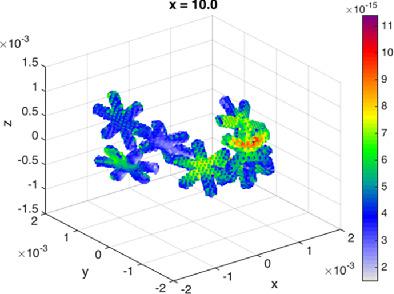当前位置:
X-MOL 学术
›
Q. J. R. Meteorol. Soc.
›
论文详情
Our official English website, www.x-mol.net, welcomes your
feedback! (Note: you will need to create a separate account there.)
An accurate and computationally cheap microwave scattering method for ice aggregates: the Independent Monomer Approximation
Quarterly Journal of the Royal Meteorological Society ( IF 3.0 ) Pub Date : 2020-12-25 , DOI: 10.1002/qj.3967 Karina McCusker 1 , Chris D. Westbrook 1 , Jani Tyynelä 2
Quarterly Journal of the Royal Meteorological Society ( IF 3.0 ) Pub Date : 2020-12-25 , DOI: 10.1002/qj.3967 Karina McCusker 1 , Chris D. Westbrook 1 , Jani Tyynelä 2
Affiliation

|
The Discrete Dipole Approximation (DDA) is widely used to simulate scattering of microwaves by snowflakes, by discretising the snowflake into small ‘dipoles’ which oscillate in response to (a) the incident wave, and (b) scattered waves from all the other dipoles in the particle. It is this coupling between all dipole pairs which makes solving the DDA system computationally expensive, and that cost grows nonlinearly as the number of crystals n within an aggregate is increased. Motivated by this, many studies have ignored the dipole coupling (the Rayleigh–Gans Approximation, RGA). However, use of RGA leads to systematic underestimation of both scattering and absorption, and an inability to predict polarimetric properties. To address this, we present a new approach (the Independent Monomer Approximation, IMA) which solves the DDA system for each crystal ‘monomer’ separately, then combines them to construct the full solution. By including intra‐monomer coupling, but neglecting inter‐monomer coupling, we save a factor of n in computation time over DDA. Benchmarking IMA against DDA solutions indicates that its accuracy is greatly superior to RGA, and provides ensemble scattering cross‐sections which closely agree with their more expensive DDA counterparts, particularly at size parameters smaller than ∼ 5 . Addition of rime to the aggregates does not significantly degrade the results, despite the increased density. The use of IMA for radar remote sensing is evaluated, and we show that multi‐wavelength and multi‐polarisation parameters are successfully captured to within a few tenths of a dB for aggregates probed with frequencies between 3 and 200 GHz, in contrast to RGA where errors of up to 2.5 dB are observed. Finally, we explore the realism of the IMA solutions in greater detail by analysing internal electric fields, and discuss some broader insights that IMA provides into the physical features of aggregates that are important for microwave scattering.
中文翻译:

一种精确且计算便宜的冰块微波散射方法:独立单体逼近
离散偶极子近似(DDA)通过将雪花离散为小的“偶极子”来响应由(a)入射波和(b)来自所有其他偶极子的散射波而被振荡,从而广泛地用于模拟雪花对微波的散射。在粒子中。正是所有偶极对之间的这种耦合使得解决DDA系统在计算上变得昂贵,并且该成本随着晶体数量n的增加而非线性增长。总量内的增加。因此,许多研究忽略了偶极耦合(瑞利-甘斯近似法,RGA)。但是,使用RGA会导致散射和吸收的系统低估,并且无法预测极化特性。为了解决这个问题,我们提出了一种新方法(独立单体逼近法,IMA),该方法分别为每个晶体“单体”求解DDA系统,然后将它们组合以构建完整的解决方案。通过包括单体内偶联,而忽略了单体间偶联,我们节省了n倍。在DDA上的计算时间。使用DDA解决方案对IMA进行基准测试表明,其精度大大优于RGA,并且提供了与更昂贵的DDA同类产品非常吻合的整体散射截面,尤其是在尺寸参数小于约5的情况下。。尽管密度增加了,但向骨料中添加雾并不会显着降低结果。评估了IMA在雷达遥感中的使用,并且我们证明,与3 GHz和200 GHz之间的频率探测到的聚集体相比,多波长和多极化参数已成功捕获到十分之几dB的范围内。观察到高达2.5 dB的误差。最后,我们通过分析内部电场来更详细地探索IMA解决方案的真实性,并讨论IMA提供的更深入的见解,这些见解对聚集体的物理特征(对于微波散射很重要)具有重要意义。
更新日期:2020-12-25
中文翻译:

一种精确且计算便宜的冰块微波散射方法:独立单体逼近
离散偶极子近似(DDA)通过将雪花离散为小的“偶极子”来响应由(a)入射波和(b)来自所有其他偶极子的散射波而被振荡,从而广泛地用于模拟雪花对微波的散射。在粒子中。正是所有偶极对之间的这种耦合使得解决DDA系统在计算上变得昂贵,并且该成本随着晶体数量n的增加而非线性增长。总量内的增加。因此,许多研究忽略了偶极耦合(瑞利-甘斯近似法,RGA)。但是,使用RGA会导致散射和吸收的系统低估,并且无法预测极化特性。为了解决这个问题,我们提出了一种新方法(独立单体逼近法,IMA),该方法分别为每个晶体“单体”求解DDA系统,然后将它们组合以构建完整的解决方案。通过包括单体内偶联,而忽略了单体间偶联,我们节省了n倍。在DDA上的计算时间。使用DDA解决方案对IMA进行基准测试表明,其精度大大优于RGA,并且提供了与更昂贵的DDA同类产品非常吻合的整体散射截面,尤其是在尺寸参数小于约5的情况下。。尽管密度增加了,但向骨料中添加雾并不会显着降低结果。评估了IMA在雷达遥感中的使用,并且我们证明,与3 GHz和200 GHz之间的频率探测到的聚集体相比,多波长和多极化参数已成功捕获到十分之几dB的范围内。观察到高达2.5 dB的误差。最后,我们通过分析内部电场来更详细地探索IMA解决方案的真实性,并讨论IMA提供的更深入的见解,这些见解对聚集体的物理特征(对于微波散射很重要)具有重要意义。











































 京公网安备 11010802027423号
京公网安备 11010802027423号